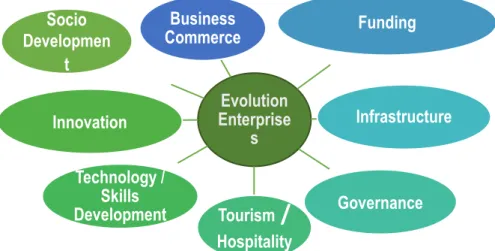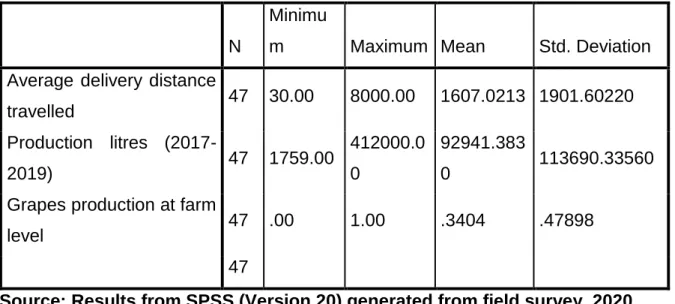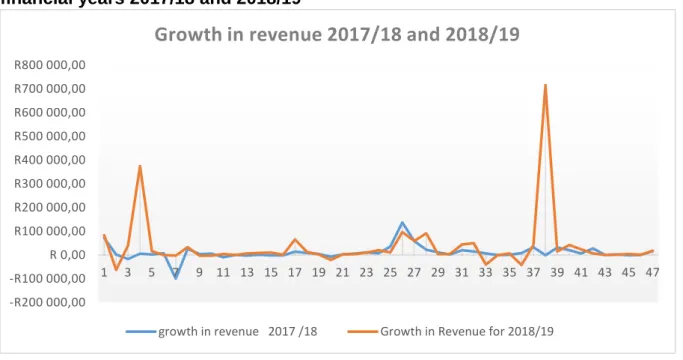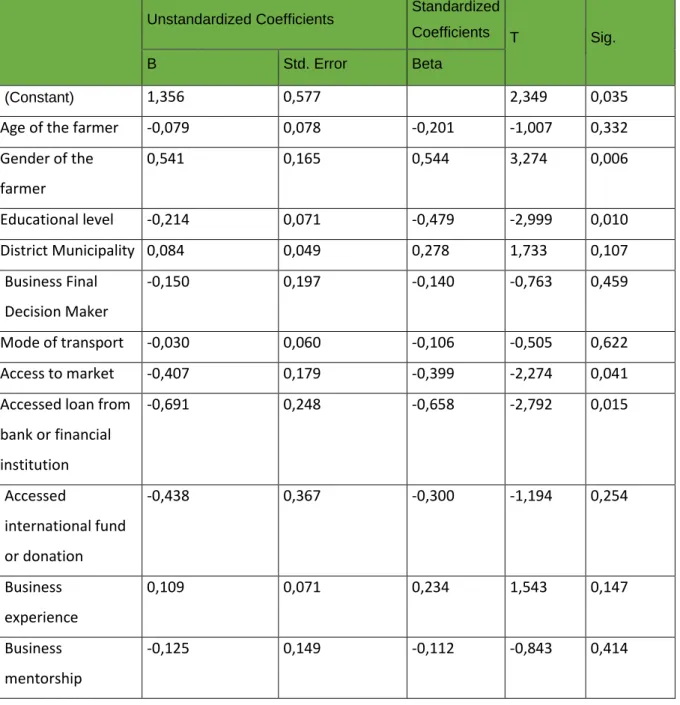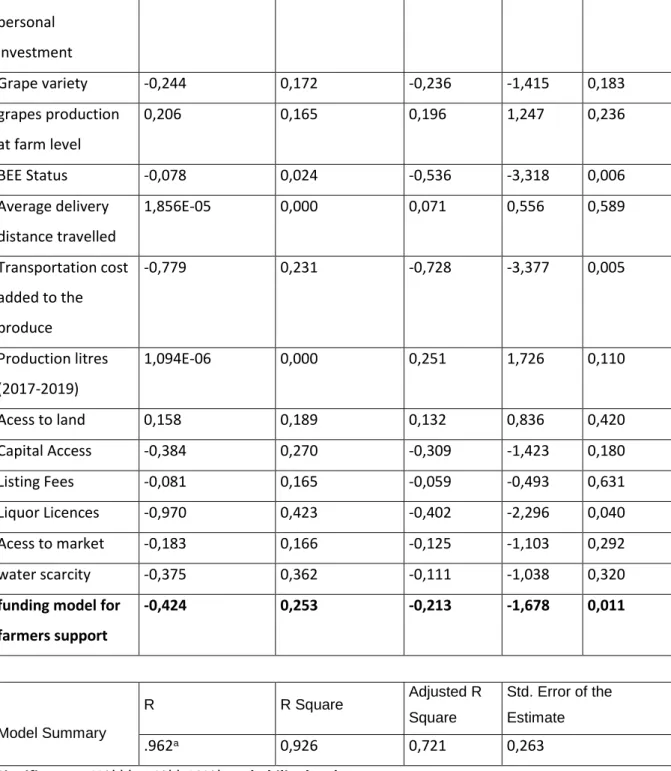This study explores existing funding patterns among red wine entrepreneurs in the Western Cape, South Africa. 44 Table 4.2: Gender, age and education level of Black Wine Entrepreneurs in the Western Cape.
Background
Below is the table indicating the economic impact of the drought on the agricultural sector in the Western Cape. For the category altenatie fits, the table shows that 220 jobs were lost, whereby the production loss was 8.5%.
Problem statement
2009) reported that black entrepreneurs need adequate capital and be involved in other economic activities that will provide them with additional income. This study sees the need for adequate capital and involvement in other economic activities as a gap that requires an in-depth assessment to examine the contribution of existing financing models to sales growth among red wine entrepreneurs.
Objectives of the study
Broad objective of the study
According to Oertle (2017), this will boost their business capital as many black entrepreneurs do not succeed in terms of loan applications for funding. The results of this study indicated that the black entrepreneurs do not succeed because they have no access to land, procurement of grapes from third parties and in some cases do not have the fixed large market entry.
Specific objectives are to
This study would be an attempt to answer the following critical questions; "Are Black Entrepreneur Wine Sales Growing Under Existing Financial Support Mechanisms?" A follow-up question that also requires deep exploration is; "What is the perception of red wine entrepreneurs about existing funding models?" and, would black wine entrepreneurs be sustainable if existing funding models were to be disrupted. To determine the contribution of existing financing models to increased market sales among red wine entrepreneurs in the Western Cape Province.
Research questions
Research hypothesis
Purpose of the study
Significance of the study
Delimitations/Scope of the study
Due to limited time, budget and the Covid-19 pandemic, the study focused on only 47 respondents from the West Coast, Overberg, Garden Route, Cape Winelands and City of Cape Town Districts of the Western Cape. This means that the results and conclusions that will be made at the end of the study will be from those parts of the province and not entirely from the entire province of South Africa.
Limitation of the study
Definition of Key Terms
This model minimizes the sum of squared distances between the observed responses in the data set and the fitted responses from the regression model.
The outline of the study
Introduction
Overview of the South African wine industry
However, drought is also a major driver within the wine industry and wine grape production fell by almost 15% in 2018 compared to the previous year. In addition, the wine industry can be distracted from the changes in macroeconomic trends and international factors such as changes in currency values, as well as a range of external factors affecting costs, such as crime and health conditions (Van Rooyen et al., 2011). .
Overview of the Financing Models
Notably, the South African wine industry relies heavily on stakeholder collaboration and partnership, encompassing both trade association groups, government departments and agencies. To ensure that the wine companies achieve productivity, sustainability, transformation and empowerment within the wine industry; they must ensure that risks such as the financial risk, exit plan and return on investment are met.
Grant Funding
- The Comprehensive Agricultural Support Programme (CASP)
- The Statutory Levy Fund
- Wines of South Africa (WOSA)
- Department of Trade and Industry (DTI)
The SA Wine and Grape Industry Transformation Unit (SAWITU) is the South African wine industry's transformation vehicle and recipients of industry transformation money. The programs focus on integration in the wine industry's full value chain, including
Loan Funding
The Land Bank
Industrial Development Cooperation (IDC)
Small Enterprise Development Agency (SEDA)
19 and promote small enterprises while also ensuring their long-term sustainability through cooperation with partners and stakeholders (Small Enterprise Development Agency SEDA, 2016). SEDA's mission is to create, assist and promote small enterprises while also ensuring their long-term sustainability through cooperation with partners and stakeholders (Small Enterprise Development Agency SEDA, 2016).
Factors influencing the economic performance of the wine firms
According to Van Rooyen et al. 2011), production costs, quality and availability of technology as well as water availability and infrastructure are essential to the economic performance of agricultural enterprises – not just wine enterprises. According to Toerien (2010), the collaborative support of the wine industry's role players has played a significant role in its success over time.
Characteristics of the wine producers
Wine Producers
The wine industry in South Africa has the most dedicated winegrowers and winemakers who are creative and bring innovation within the industry. Private wine cellars are role players/entities owned by a person or group that accepts grapes, processes them into wine grape products and sells them packaged or in bulk.
Wine brand companies
Solms Delta in Franschhoek and Koopmandkloof Winery are two examples of black owned wineries with shares in land and production (Business Day BD Live, 2015). There is a shortage of black winemakers who can be brand owners or act on behalf of black brands.
Determinants of wine market sales – empirical evidence from other countries
According to the empirical evidence, commercial alliances, larger-scale innovation and a successful export commitment in the French wine sector are associated with higher export performance. All three regression approaches used in the study show that knowledge is still the most important factor in wine consumption.
The effect of funding models on sales – empirical evidence from other countries
Their study showed that export performance by businesses will improve sales growth. The largest predictors of wine consumption were knowledge about wine, drinking wine for relaxation, and sociability. The strongest determinants of wine spending were bargain shopping, attending wine events, and viewing wine as a nutritional beverage. This means that customers also depend on. Furthermore, there is a significant positive relationship between knowledge and volume of wine drunk.
Theoretical framework
Theoretical framework for a competitive wine business
26 financing of member states for their development, modernization and expansion, not only economically, but also socially. According to the survey, the group's gains from the program include input support, asset purchase, rural infrastructure, advisory services, capacity building, increased production and revenue. This is another important factor to investigate among black entrepreneurs in the South African wine industry in terms of their market performance over time, whether their sales are increasing or not. Figure 1 below shows a schematic framework with business competitiveness factors in the wine industry.
The conceptual framework of the funding models: funding opportunities with
28 of this kind should be discontinued, black entrepreneurs within the wine sector will need to be able to sustain themselves. A study was conducted in Mozambique by Hilmi (2009), but its main focus was the farmers association to assess whether the newly implemented model will be able to bring greater sustainability or not. The findings of the study indicated that farmers need to equip themselves and find ways to generate capital without the support of financial institutions.
Chapter Summary
Introduction
Description of the study area
30 to the geographical wine regions, which are located at the intersection of the Indian and Atlantic Oceans. The two main types of research paradigms are (i) the positivist paradigm which is applied by most scientific or quantitative researchers as a conceptual framework for the search. In the pure sciences, positivism is preferred due to its empirical nature to study facts, and (ii) on the other hand, the interpretivist paradigm is used by most of the qualitative researchers in the social sciences.
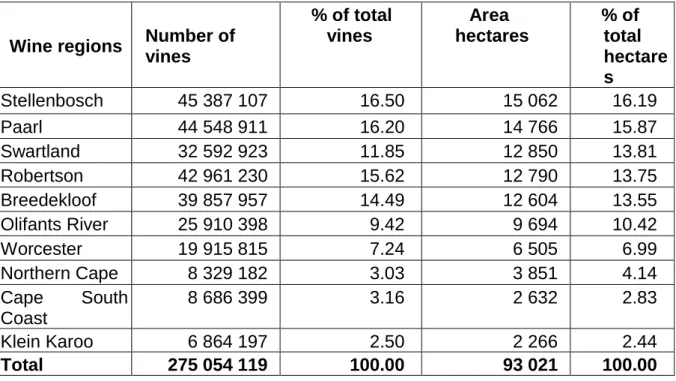
Research Approach
Research Design
Population, sample and sampling techniques
Sample and sampling technique
Remarkably, according to Foley (2018), purposive sampling is extremely time and cost effective because a researcher selects a unit from the population that fits the information needs of the study. This would allow the study to gather sufficient information and draw a conclusion based on a representative sample of the existing population of respondents. These entrepreneurs were selected because they fit the purpose of the research and provided information about smallholder entrepreneurship within the wine industry. They will give their opinion on the financing models used.
Data collection instrument
However, the 47 existing black wine industry entrepreneurs were purposefully selected as participants in this study. Furthermore, the locations and contact information of the wine brand entrepreneurs are readily available on the website (database) as indicated in WOSA (2018). Secondary data which was related to the topic was collected from various literature sources such as previous studies conducted in the area and reports on the performance of the South African wine industry.
Data capturing, processing and analysis
35 farm-level production, BEE status, average delivery distance traveled, transport costs added to product, liters of production and sales market growth (after financial support). Graphs were drawn using Microsoft Excel 2016 with the results obtained using frequency run by the Statistical Package for the Social Sciences (SPSS). SPSS was further used to describe red wine entrepreneurs' perceptions of existing financing models.
Primary data collection
- To describe the socio-economic characteristics of black wine entrepreneurs
- To assess the existing financing models amongst the black wine
- To describe the trends or patterns of market sales growth amongst the
- To determine the perception of the Black wine entrepreneurs on the existing
- To determine the factors influencing the market sales growth amongst the
- Justification of the econometric model
The descriptive statistics were also used to find out from which of the funding models (grant or credit/loan) the Black Wine entrepreneurs get support or not. This information was provided by the Black Wine entrepreneurs in the Western Cape Province of South Africa. Furthermore, the linear regression model was used to run the independent variable to check the contribution these factors have to the market sales growth among Black Wine entrepreneurs in the Western Cape.
Ethical considerations
Under this objective, the researcher tries to measure the contribution that the financing models have on the market sales growth. In this case, the funding models, which include grants and credit or loan financing, were the dependent variable.
Summary
To assess the existing financing models among the black wine entrepreneurs in the Western Cape Province. What are the existing financing models among the black wine entrepreneurs in the Western Cape province? What contribution do the existing financing models make to the market turnover growth among black wine entrepreneurs in the Western Cape province?
Introduction
- Socio-economic characteristics of the Black wine entrepreneurs
- Respondents by district location
- Gender, age and educational level attained by the respondents
- Production Information
- Market Support Services amongst Black Wine Entrepreneurs
- Business Funding Mechanisms amongst the Black Wine Entrepreneurs
- Average delivery distance travelled
- Discussion of results
- Describing the socio-economic characteristics of black wine entrepreneurs in the
- Gender of the Black wine entrepreneurs versus funding models
- Assessing the existing financing models amongst the black wine entrepreneurs in the
- Describing the trend analysis of market sales growth amongst the Black wine
- Determining the factors influencing the market sales growth amongst the Black Wine
- Access to private companies
- BEE status
- Determining the contribution of the existing financing models on the market sales
- Conclusion
45 Table 4.2: Gender, age and education level of red wine entrepreneurs in the Western Cape. It showed that 72.3% of black wine entrepreneurs are trained in financial management. However, 27.7% of the entrepreneurs indicated that they have no training in farm finance management.
Many Black Wine entrepreneurs indicated that they do not sell their products internationally. The majority (87.2%) of Black Wine entrepreneurs stated that they do not have access to international financing.
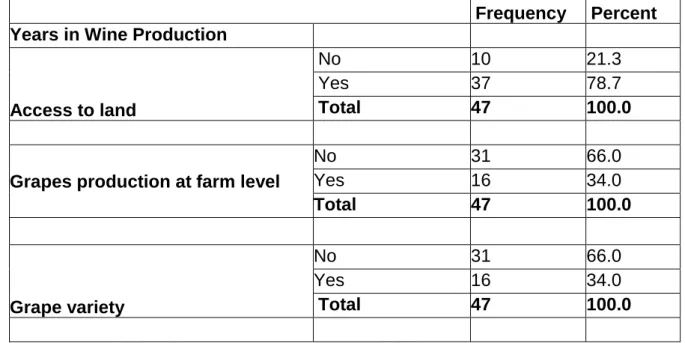
- Introduction
- Summary
- Conclusion
- Suggestions for future research
- REFERENCES
Additionally, the linear regression model was used to determine the contribution of existing funding models to increased market sales among red wine entrepreneurs in the Western Cape Province. The SA Wine and Grape Industry Transformation Unit (SAWITU) is the vehicle for the transformation of the South African wine industry and a recipe for industry transformation money. The purpose of the questionnaire is to collect data that would help assess the impact of existing financing models on increasing market sales in the wine industry.

